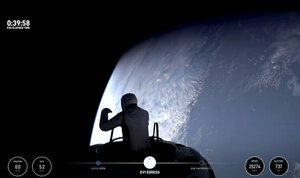One small walk for a tech billionaire, one giant leap for ultra wealthy space tourists
Emerging from the hatch into the cold vacuum of space, tech billionaire Jared Isaacman joined an elite group of professional astronauts from a dozen countries. He tested SpaceX’s new spacesuits, clinging to a spacecraft going farther than any since 1972.

The image from a SpaceX video shows the start of the first private spacewalk led by tech billionaire Jared Isaacman Sept. 12, 2024.
SpaceX/AP
Cape Canaveral, Fla.
A tech billionaire performed the first private spacewalk hundreds of miles above Earth on Sept. 12, a high-risk endeavor reserved for professional astronauts – until now.
Tech entrepreneur Jared Isaacman teamed up with SpaceX to test the company’s brand new spacesuits on his chartered flight. The daring spacewalk also saw SpaceX engineer Sarah Gillis going out once Mr. Isaacman was safely back inside.
This spacewalk was simple and quick – less than two hours – compared with the drawn-out affairs conducted by NASA. Astronauts at the International Space Station often need to move across the sprawling complex for repairs, always traveling in pairs and lugging gear. Station spacewalks can last seven to eight hours.
Mr. Isaacman emerged first from the hatch, joining a small elite group of spacewalkers who until now had included only professional astronauts from a dozen countries.
“Back at home, we all have a lot of work to do. But from here, it sure looks like a perfect world,” Mr. Isaacman said as the capsule soared above the South Pacific. Cameras on board caught his silhouette, waist high at the hatch, with the blue Earth beneath.
The commercial spacewalk was the main focus of the five-day flight financed by Mr. Isaacman and Elon Musk’s company, and the culmination of years of development geared toward settling Mars and other planets.
All four on board donned the new spacewalking suits to protect themselves from the harsh vacuum. They launched on Sept. 10 from Florida, rocketing farther from Earth than anyone since NASA’s moonwalkers. The orbit was reduced by half – to 460 miles (740 kilometers) – for the spacewalk.
This first spacewalking test involved more stretching than walking. Mr. Isaacman kept a hand or foot attached to it the whole time as he flexed his arms and legs to see how the spacesuit held up. The hatch sported a walker-like structure for extra support.
After roughly 10 minutes outside, Mr. Isaacman was replaced by SpaceX engineer Sarah Gillis to go through the same motions. Ms. Gillis bobbed up and down in weightlessness, no higher than her knees out of the capsule, as she twisted her arms and sent reports back to Mission Control.
Each had 12-foot (3.6-meter) tethers but did not unfurl them or dangle at the end unlike what happens at the space station, where astronauts routinely float out at a much lower orbit.
More and more wealthy passengers are plunking down huge sums for rides aboard private rockets to experience a few minutes of weightlessness. Others have spent tens of millions to stay in space for days or even weeks. Space experts and risk analysts say it’s inevitable that some will seek the thrill of spacewalking, deemed one of the most dangerous parts of spaceflight after launch and reentry but also the most soul-stirring.
This operation was planned down to the minute with little room for error. Trying out new spacesuits from a spacecraft new to spacewalking added to the risk. So did the fact that the entire capsule was exposed to the vacuum of space.
There were a few glitches. Mr. Isaacman had to manually pull the hatch open instead of pushing a button on board. Before heading out, Ms. Gillis reported seeing bulges in the hatch seal.
Scott “Kidd” Poteet, a former Air Force Thunderbird pilot, and SpaceX engineer Anna Menon stayed strapped to their seats to monitor from inside. All four underwent intensive training before the trip.
Mission controllers announced the spacewalk complete from company headquarters in Hawthorne, California, after one hour and 46 minutes – or a full swing and then some around Earth.
It went by “in the blink of an eye,” said SpaceX commentator Kate Tice.
Mr. Isaacman, 41, CEO and founder of the Shift4 credit card-processing company, has declined to disclose how much he invested in the flight. It was the first of three flights in a program he’s dubbed Polaris; this one was called Polaris Dawn. For SpaceX’s inaugural private flight in 2021, he took up contest winners and a cancer survivor.
Until Sept. 12, only 263 people had conducted a spacewalk, representing 12 countries. The Soviet Union’s Alexei Leonov kicked it off in 1965, followed a few months later by NASA’s Ed White.
This story was reported by The Associated Press.

